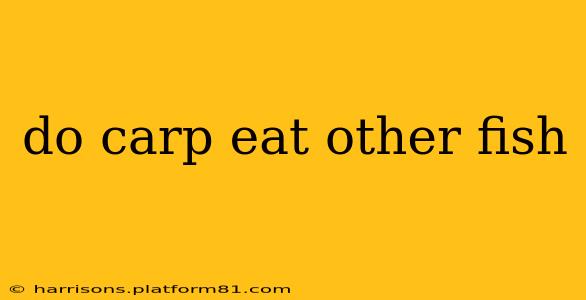Carp, particularly common carp ( Cyprinus carpio), are often perceived as bottom-feeding, plant-eating fish. While this is partially true, the reality of their diet is more complex and opportunistic. The short answer is: yes, carp can and do eat other fish, especially when given the opportunity. However, it's not their primary food source.
This article will explore the diverse diet of carp, addressing common questions about their predatory behavior and impact on aquatic ecosystems.
What is the primary food source for carp?
Carp are omnivorous, meaning they consume both plants and animals. Their diet varies depending on their age, size, and the availability of food in their environment. At younger ages, they primarily feed on zooplankton and invertebrates. As they grow, their diet expands to include a wider range of items. Their primary food sources generally include:
- Aquatic plants: Carp readily consume various aquatic plants, algae, and decaying vegetation. This makes them significant herbivores in many water bodies.
- Invertebrates: They are voracious consumers of insects, insect larvae, crustaceans (like snails and crayfish), and worms.
- Detritus: Carp also feed on organic matter, sediment, and decaying organic materials found at the bottom of water bodies.
Do carp eat small fish?
While not their primary diet, carp are capable of and do eat small fish. This predatory behavior is more likely to occur when:
- Food scarcity: If their preferred food sources (plants and invertebrates) are scarce, they may turn to small fish as an alternative food source.
- Opportunity: Carp are opportunistic feeders. If a small fish is presented as an easy meal, they will likely consume it.
- Size and age: Larger carp are more likely to prey on small fish than smaller individuals.
What other animals do carp eat?
Besides small fish, carp can also consume:
- Amphibian larvae: Tadpoles and other amphibian larvae are sometimes part of their diet.
- Fish eggs: Carp can also feed on the eggs of other fish species, contributing to a decrease in their population.
- Other invertebrates: Their invertebrate consumption includes a vast array of organisms, depending on habitat.
Are carp considered invasive species?
In many parts of the world, carp are considered invasive species. Their voracious feeding habits, including their consumption of smaller fish and eggs, can disrupt the balance of aquatic ecosystems. Their rooting behavior can also damage aquatic plant life, impacting the overall habitat and negatively influencing other species. Their impact on native fish populations, through predation and competition for resources, is a significant concern.
How do carp affect the ecosystem?
The ecological impact of carp is complex and multifaceted. While they can contribute to nutrient cycling through their consumption of decaying organic matter, their overall effect is often considered negative. Their feeding habits, particularly their disruption of aquatic plants and predation on native species, can lead to significant changes in ecosystem structure and biodiversity.
What are some methods to control carp populations?
Managing carp populations is a significant challenge in many regions. Methods employed to control their numbers include:
- Fishing: Commercial fishing and recreational fishing can help reduce carp populations.
- Habitat modification: Altering habitats to make them less suitable for carp can help limit their proliferation.
- Biological control: Introducing predators or diseases can potentially control carp numbers, but this approach requires careful consideration to avoid unintended consequences.
In conclusion, while carp are primarily herbivores and detritivores, their opportunistic feeding habits demonstrate their capacity to consume small fish and other animals. This predatory behavior, along with their impact on aquatic vegetation, highlights the complex ecological role of carp and the need for effective management strategies to mitigate their potential negative effects on aquatic ecosystems.
